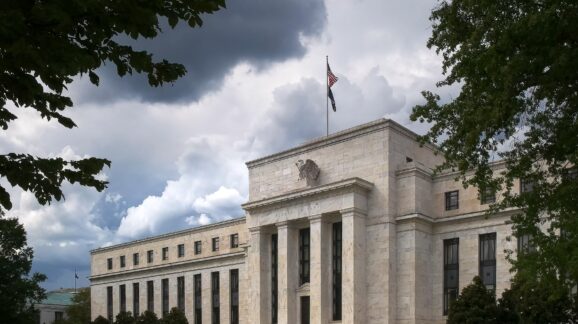Is the Fed done with interest rate hikes?

Photo Credit: Getty
The Federal Reserve’s Open Market Committee held the federal funds rate steady this week at its most recent meeting, as expected. It will range between 5.25 and 5.50 percent. Fed Chair Jerome Powell also hinted that the Fed may be done with interest rate increases for the foreseeable future, barring a change in economic conditions.
Inflation remains about double its 2 percent target, so an interest rate increase would have sent a sterner message to markets about the Fed’s seriousness about inflation control. But because the Fed’s actions work on a lag, earlier increases may still be working their way through the financial system.
Other variables are in play. The political branches of government want lower interest rates, because higher rates make government debt more expensive to repay. This year’s spending deficit is up to $1.7 trillion. Congressional Budget Office projections estimate that annual deficits will average $2 trillion through 2033. Total government debt is $33 trillion and increasing fast. Interest payments for 2023 alone are $659 billion. At this point, even a quarter-percent interest rate increase would increase annual debt service costs by tens of billions of dollars per year.
Powell has maintained a strong commitment to fighting inflation. COVID-era hyper-stimulus from the Fed and from Congress and Presidents Trump and Biden caused today’s inflation, so Powell is not blameless. He helped cause this mess. But he has been doing most of the right things for the last year and a half, which is why inflation has gone down from 9 percent to under 4 percent. There is still a ways to go, so Powell’s newfound commitment to inflation control is welcome.
The trouble is that inflation is not entirely in Powell’s hands. If it were, it would likely be back to normal by now. The Fed more or less has to finance new deficit spending, and that is the main trouble. Congress has yet to pass a new farm bill and a new omnibus, which will add a still-unknown amount of deficit spending. While no new major bills like the CHIPS Act or the infrastructure bill are on the way, that could always change during the coming election year.
Another, more distant problem is that the Fed is likely to begin another round of bond-buying in 2026 or 2027. It is currently shrinking its portfolio by letting maturing bonds expire, and retiring those dollars from circulation. This decreases the money supply, which decreases inflation.
After a few years of this, its portfolio will be close to where it was before the pandemic. The Fed will likely want to replenish its shrinking portfolio, which means buying more bonds again. It buys these bonds with dollars, which then circulate throughout the economy. This directly increases the money supply, which increases inflation.
If markets expect that type of inflation to happen down the road, that will factor into today’s inflation expectations. That makes it even harder for the Fed to control inflation both now and later, even without any new spending from Congress and the White House.
The Fed’s Open Market Committee has one more interest rate decision to make this year, at its next meeting on December 12-13. With the economy in otherwise good shape, there is room for another increase if the Fed wants to further manage inflation expectations, though odds are it will hold steady.
While we’re past the worst of the COVID inflation, policymakers should consider three reforms to prevent another inflationary episode during the next crisis.
One, the Fed should follow a binding formal rule for its monetary policy. There are several options, ranging from a Taylor rule that focuses on interest rates to nominal GDP (NGDP) targeting. This would prevent the Fed from rapidly growing the money supply and causing inflation. It currently has almost unlimited discretion on monetary policy, which is why it was able to grow the money supply by 40 percent in two years during the pandemic, which is more than quadruple the usual rate. A binding rule would also give the Fed a way to resist political pressure to stimulate the economy ahead of an election or during a crisis.
Second, Congress should simplify the Fed’s dual mandate. The Fed has two jobs, which often contradict each other. It is supposed to keep unemployment low, which it can do by stimulating the economy through low interest rates and a growing money supply. It is also supposed to keep inflation low, which often means higher interest rates, and matching money supply growth as closely as possible to real economic growth.
These two mandates often contradict each other, so Fed officials have to use their discretion to choose which one to follow at a given time. This causes instability and provides an opening to political pressure from the elected branches. To preserve its independence, the Fed should instead have a single mandate of keeping inflation low. If Congress or the president want stimulus, there are other ways, though ideally they would restrain themselves in the first place.
Which ties into the third solution: Spend less. While the Fed sets its policies independently, if politicians saddle the Fed with a massive load of debt, the Fed more or less has to help finance it. This often means buying bonds, which increases the money supply, which in turn raises inflation. A less spend-happy Washington would make it easier for the Fed to keep inflation low in the first place. It would also leave more resources available for entrepreneurs to finance their ideas and create new wealth, new innovations, and raise living standards.